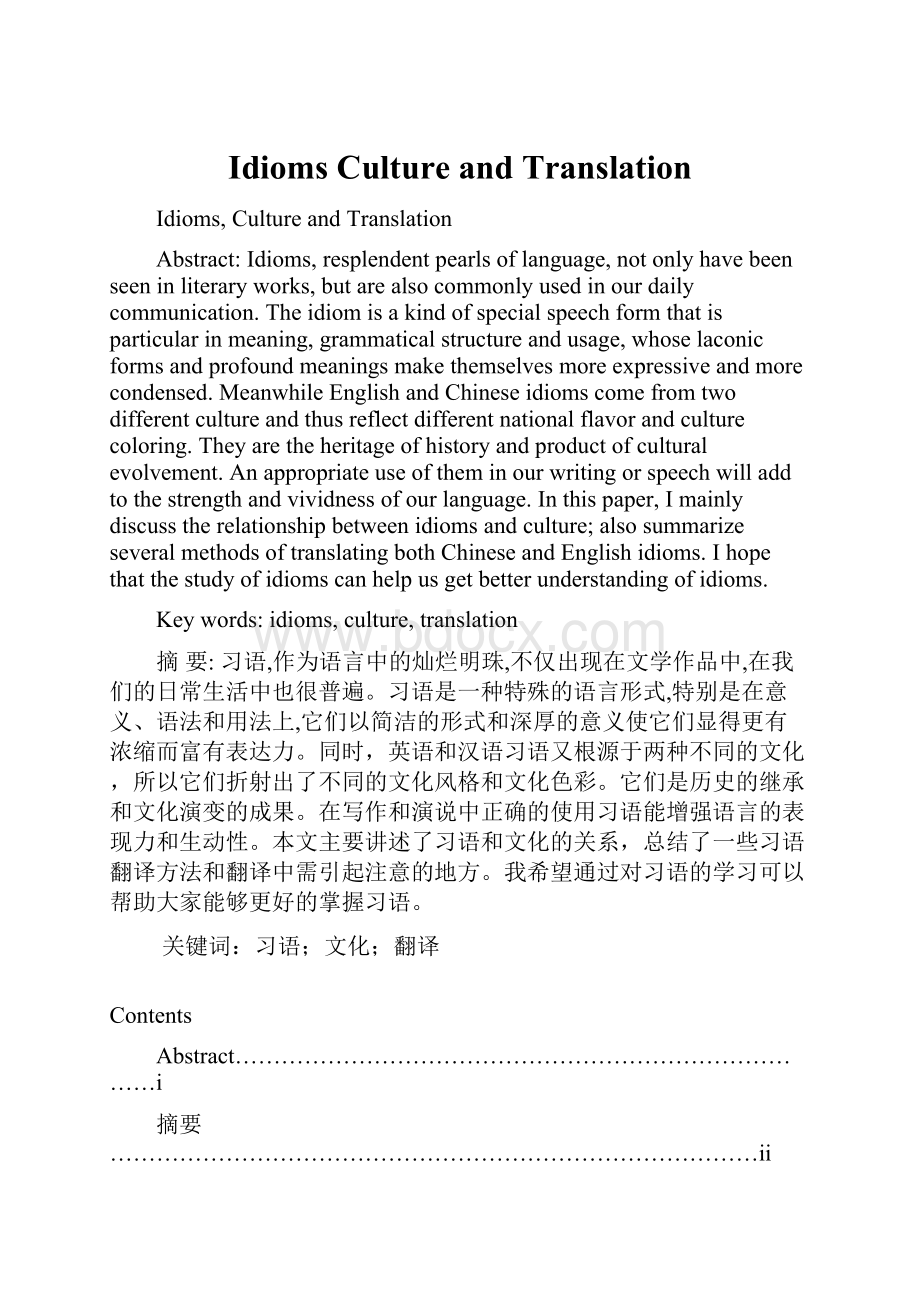Idioms Culture and Translation.docx
《Idioms Culture and Translation.docx》由会员分享,可在线阅读,更多相关《Idioms Culture and Translation.docx(13页珍藏版)》请在冰豆网上搜索。

IdiomsCultureandTranslation
Idioms,CultureandTranslation
Abstract:
Idioms,resplendentpearlsoflanguage,notonlyhavebeenseeninliteraryworks,butarealsocommonlyusedinourdailycommunication.Theidiomisakindofspecialspeechformthatisparticularinmeaning,grammaticalstructureandusage,whoselaconicformsandprofoundmeaningsmakethemselvesmoreexpressiveandmorecondensed.MeanwhileEnglishandChineseidiomscomefromtwodifferentcultureandthusreflectdifferentnationalflavorandculturecoloring.Theyaretheheritageofhistoryandproductofculturalevolvement.Anappropriateuseoftheminourwritingorspeechwilladdtothestrengthandvividnessofourlanguage.Inthispaper,Imainlydiscusstherelationshipbetweenidiomsandculture;alsosummarizeseveralmethodsoftranslatingbothChineseandEnglishidioms.Ihopethatthestudyofidiomscanhelpusgetbetterunderstandingofidioms.
Keywords:
idioms,culture,translation
摘要:
习语,作为语言中的灿烂明珠,不仅出现在文学作品中,在我们的日常生活中也很普遍。
习语是一种特殊的语言形式,特别是在意义、语法和用法上,它们以简洁的形式和深厚的意义使它们显得更有浓缩而富有表达力。
同时,英语和汉语习语又根源于两种不同的文化,所以它们折射出了不同的文化风格和文化色彩。
它们是历史的继承和文化演变的成果。
在写作和演说中正确的使用习语能增强语言的表现力和生动性。
本文主要讲述了习语和文化的关系,总结了一些习语翻译方法和翻译中需引起注意的地方。
我希望通过对习语的学习可以帮助大家能够更好的掌握习语。
关键词:
习语;文化;翻译
Contents
Abstract……………………………………………………………………i
摘要…………………………………………………………………………ii
Contents…………………………………………………………………iii
Introduction…………………………………………………………………1
1.Definition……………………………………………………………1
2.Characteristics…………………………………………………………3
2.1Semanticunity…………………………………………………………3
2.2Structuralstability……………………………………………………4
2.3Grammatical…………………………………………………………5
3.CulturaldifferencesreflectedbyChineseandEnglishidioms……6
3.1Geographicaldifferences………………………………………………7
3.2Conventionaldifferences………………………………………………8
3.3Valueorientationdifferences…………………………………………9
3.4Religiousdifference…………………………………………………9
4.Translationofidioms……………………………………………………11
4.1ComparisonandcontrastbetweenChineseandEnglishidioms……12
4.2HowtotranslatecorrectlybetweenChineseandEnglishidioms……13
Conclusion…………………………………………………………………16
Bibliography………………………………………………………………17
Acknowledgement…………………………………………………………18
Introduction
Idiomsnotonlyhavebeenseeninliteraryworks,butarealsocommonlyusedinourdailycommunication.BothChineseandEnglishlanguageaboundswithidioms.Therefore,idiomsplayanimportantroleinourlanguage.Butitisdifficultforustounderstandanduseidiomscorrectly.EspeciallyforourChinesestudents,Englishidiomsareastumblingblock,anditisverypossiblethattheyoftennotonlyfeelatalossinunderstandingconversationsbecauseofakeyidiombutalsomisuseidioms.
First,inthisthesis,theauthorbrieflyillustratesthedefinitionandcharacteristicofidioms.Then,theauthordiscussesculturaldifferencesreflectedbyChineseandEnglishidioms.Atlast,thereisasummaryofsomemethodsoftranslatingbothChineseandEnglishidioms.Ihopethatacomparativestudyofidiomscanhelpustogetbetterunderstandingofthemandavoidmakingunnecessarymistakesinourcommunication.
1.Definition
“Idiom”isalmostacatchwordofmostEnglishlearnersandEnglishusers,butfewcanmakeitveryclearwhatanidiomisandhowitisformed.Thequestionsaboutidiomshaveattractedmanyscholars’attention.
Weinreichdefinesanidiomasfollows:
aphraselogicalunitinvolvingatleasttwopolysemousconstituents,andinwhichthereisareciprocalcontextualselectionofsubsenses.(ProblemsintheAnalysisofIdioms.1969:
42)[1]
Webster’sThirdNewInternationalDictionary(1976)definesthetermidiomasanexpressionestablishedintheusageofalanguagethatispeculiartoitselfeitheringrammaticalconstructionorinhavingameaningthatcannotbederivedasawholefromtheconjoinedmeaningsofitselements.
Fromthedefinitionsmentionedabove,wemightcometoaconclusionthatEnglishidiomsareestablishedexpressionsorphraseswhosemeaningcannotbeliterallyderived;andidioms,meantinabroadsense,maycovernotonlyfixedphrasesbutalsowhatgrammaticallyfunctionsasaclauseorsentencesuchasproverbs,slangexpressionsandcolloquialisms.
Chineseidioms,accordingtoADictionaryofContemporaryChineseIdioms(《现代汉语成语词典》1991)arefixedphrases,evenshortsentences,simpleinform,penetratinginmeaning,establishedbycommonpracticeandlongusage;AndChineseidiomsaremostlycomposedoffourcharacters.Itisexplicitthatbesidessetphrasessuchas“不卑不亢”“鹤立鸡群”“画蛇添足”someincisiveshortsentencesarealsoidioms.Forexamples:
三人行必有我师
宁为玉碎,不为瓦全
Obviously,“成语”intheaboveisdefinedinitsnarrowsense,Infact,quiteafewmodernlinguisticshaveenlargedthescopeoftheterm-idiom.
ShiShi,afamousChinesescholaronlexicon,thinksthatanyestablishedfixedexpression,whichcontainsacertainmetaphoricalmeaningisanidiom.
FromtheabovedefinitionsofChineseidioms,wecanseetheirreferencesarealmostthesameasthoseofEnglishidioms.
2.Characteristics
Asaparticularlinguisticunit,idiomsenjoytheirownuniquecharacteristics.ThoughEnglishandChinesebelongtodifferentlanguagefamilies,theiridiomshavemanyfeaturesincommon,suchassemanticunity,structuralstability,andgrammaticalirregularityandsoon.
2.1Semanticunity
Comparedwithfreephrasesandsentences,bothEnglishandChineseidiomshaveamoststrikingfeature—semanticunity.Themeaningofanidiomasawholeisnotpredictablefromthatofitscomponentparts,whichlacktheirusualmeanings.Forexample,‘smellarat’(suspectsomethinguntrue)hasnothingtodowiththeanimal‘rat’,‘anotherpairofshoes’isnotconnectedwithanythinginvolving‘shoes’.AsfortheChineseidioms“蒙在鼓里”and“宵衣旰食”,theliteralmeaningofthememberwordshasnorelevance,whatsoever,atleastsynchronicallytothemeaningofthetwoidioms‘bekeptinthedark’and‘bebusywithstateaffairs’.Thesemanticunityisalsoembodiedinthiswaythattheidiomfunctionsasoneword.Forexample,‘tillthecowscomehome’,whichcomprisesaconjunction‘till’,anarticle‘the’,anoun‘cow’,averb‘come’andanadverb‘home’,means‘forever’andfunctionsasanadverb,thusreplacingtheword‘forever’.Thesamecanbesaidof‘keepinmind’(remember),‘takeoff’(imitate)‘likeabreeze’(easily)andsoon.[2]
Someidiomsaremetaphoricalexpressions.Thereissomeconnectionbetweenthemeaningofanidiomasawholeandthelexicalmeaningofitspartsas‘beintheclouds’and“五光十色”.Eventheseidioms,however,arenotassemanticallytransparentasfreephases.Forexample:
(1)Allthewayhome,Iwasintheclouds,Hastingstalking,Inotbearingaword.(在回家的路上,我心不在焉,赫斯丁讲个不休,我却一个字也没听进去).Here‘wasinthecloud’means‘wasabsent-minded’andshouldnotbetranslatedinto“在云层中”.
2.2Structuralstability
Beingestablishedbyusage,anidiomgenerallycan’tbealtered;nocomponentwordcanbeomittedarbitrarilyorbesubstitutedbyanyothersynonymouswordintheidiom;andthearrangementofthewordscanrarelybemodified,anyattemptedchangeinthewordingorcollocationwillcommonlydestroytheidiomandperhapsrendertheexpressionmeaninglessForexample,‘toselllikehotcakes’and‘totalknineteentothedozen’aretwoidioms.Wecannotchangetheninto‘toselllikehotbread’and‘totalktwentytothedozen’.SimilarlyinChinese,“抛砖引玉”and“欲速则不达”cannotbechangedinto“抛石引玉”and“欲快则不达”.
However,itmustbepointedoutthatstabilityisamatterofdegreeorscaleandisnotabsolute.Incommunicationpeopleoftenchangeidiomstomeettheneedofrhetoricandemotionalcoloring.Maybetheproverbisveryfamiliartousthat‘failureisthemotherofsuccess.Withsomechanges,peoplecreateanotherproverb‘necessityisthemotherofinvention'.
2.3Grammaticalirregularity
Manyidiomsdonotfollowanystandardrules,fortheyoftenviolateconventionalgrammaticalrules.Herearesomeexamplestoillustratethispoint:
‘Onthemove’,‘onthego’,verbs‘move’and‘go’areusedasnouns.
‘Insandouts’,prepositionshavepluralswhileintheexpression‘atsixesandsevens’numeralshaveplurals.
‘(As)sureaseggsiseggs’(quitecertainly)mayserveasanotherexample.Theverb‘is’intheidiomshouldbe‘are’accordingtogrammaticalrules.However,weuseitasitis.Itisgrammaticallywrong,butidiomaticandwidelyaccepted.[3]AsfarasChineseidiomsareconcerned,thatis,intheshiftoftheirconstituentspartofspeech,especiallyinthepopularphenomenaofnounsusedasverbs,forexample,“衣冠禽兽”,“不毛之地”,manyChineseidiomsviolatethegrammaticalrulesofmodernstandardChineseasmostofthemarewritteninclassicalChinese,whichisoftenquitedifferentinstructurefromthemodernvernacular.Thus,“一心一意”wouldbe“一个心一个意”.But,tofillinthesefunctionwordsonlyresultsindestroyingtheidiomitselfandlosingtheflavoroftheidioms.
3.CulturalDifferencesReflectedbyChineseandEnglishIdioms
BothChinaandBritainhavealonghistory,whichfertilizedtheirbrilliantcultures.Thecommonexperiencesandreciprocalinteractioninvariousaspectsthroughlong-timecommunicationbetweenthetwocountriesinducealotofcommonpointsinculture.
InearlyBritishhistory,BritainwasoccupiedbytheRomanEmpirefornearlyfourhundredyears.TheRomanslefttheirdeepmarksonBritainculture.In49B.C.theRomanemperorCaesarsenttheorderofburningoutboatsafterhisarmypassedLupineRiver,showingthedeterminationtotakeaall-outwar,thatistheoriginoftheEnglishidiom‘burnone’sboat’(谢金良,1986).Incidentally,in208B.C.GeneralXiangyuinChinasentthesimilarordertosmashalltheboatsafterthearmypassedRiverZhanginattempttoshowitsdeter